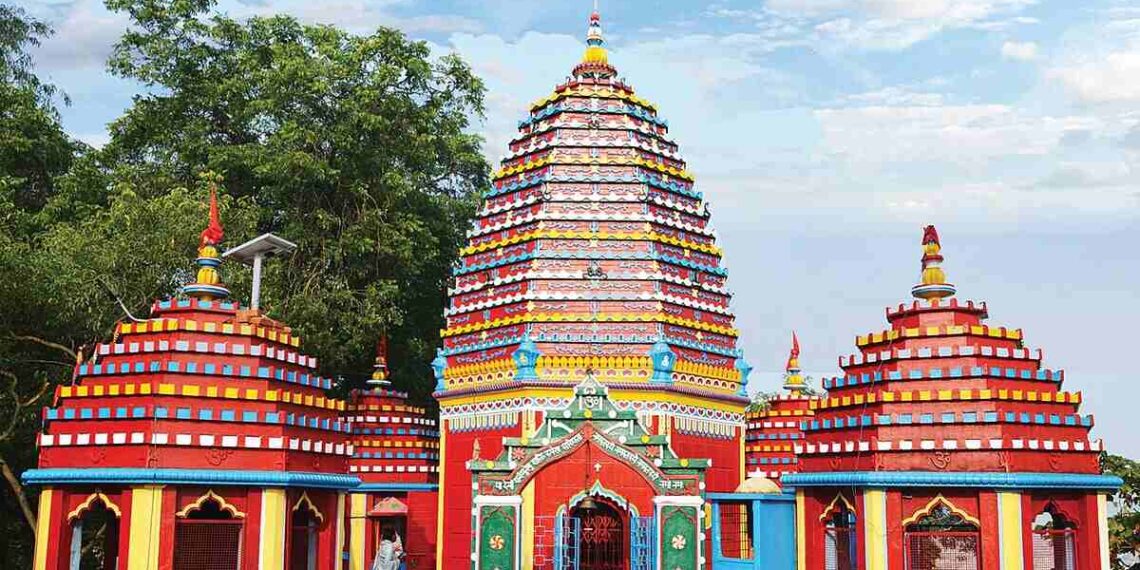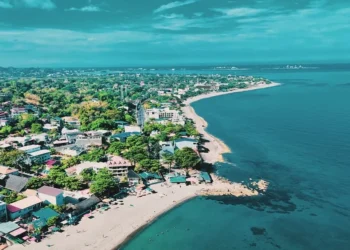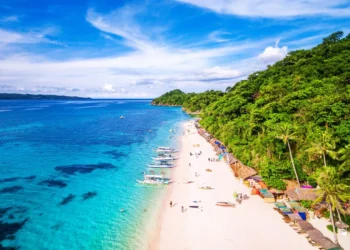Located atop a hillock at the confluence of the Damodar and Bhairavi rivers in Rajrappa, Ramgarh district, Jharkhand, the Chhinnamasta Temple is a sacred shrine dedicated to Goddess Chhinnamasta, a fierce form of Devi, the Divine Mother. The temple came to existence long ago, with roots in ancient times, and is famed for its headless deity, a striking symbol of self-sacrifice and power. Its scenic riverside spot and tantric heritage draw many seeking blessings and transformation.
Notable Fact: The temple’s idol, depicting Chhinnamasta headless and standing on Kamadeva and Rati, is one of the rarest in India, tied to its status as a Shakti Peeth where Sati’s head is believed to have fallen.
Overview of Chhinnamasta Temple
Chhinnamasta Temple, located in Rajrappa, 28 km from Ramgarh Cantonment, is a key Hindu pilgrimage site for Shaktism, one of the six major paths. Known for its 25-foot-high headless deity, carved from red sandstone, it follows a tantric architectural style with a dome-shaped roof. The temple complex, covering 10 hectares, includes 10 temples for Surya, Shiva, Hanuman, and the Mahavidyas. Devotees offer milk, flowers, and animal sacrifices, believing Chhinnamsta grants wishes. The temple trust, established in the 19th century, maintains the site, with new guesthouses added in 2010. It is a sacred stop for Hindus and tribal Santals, tied to Jharkhand’s spiritual heritage.
History of Chhinnamasta Temple
Records suggest the temple’s origins trace to pre-Vedic times, though the current structure was rebuilt in the 18th century after earlier destruction. The site is mentioned in the Vedas, Puranas, and Durga Saptashati as a Shakti Peeth, where Sati’s head fell. Legend from the Markandeya Purana states Chhinnamasta severed her head to feed her attendants, Jaya and Vijaya, after slaying demons, embodying self-sacrifice. Another tale claims Raja Surath worshipped here, advised by Medha Rishi, earning the goddess’s blessings, naming the site Rajtapah, later Rajrappa. By the 8th century, saints like Adi Shankaracharya and Chaitanya Mahaprabhu visited, cementing its fame. The temple survived medieval invasions, with its idol preserved. In 1950, the Raja of Ramgarh gifted 3 acres for the Bhudan Movement. Today, it hosts 2500–3000 daily visitors, peaking at 200,000 during Navratri.
Architecture of Chhinnamasta Temple
Chhinnamasta Temple, set on a 30-meter-high hillock, follows a tantric Kamrup style, resembling Assam’s Kamakhya Temple. Its main shrine, 10 meters by 10 meters, has a dome-shaped roof, 5 meters high, made of brick and plaster. The sanctum houses a 25-foot red sandstone idol of Chhinnamasta, standing on Kamadeva and Rati in a lotus bed, covered with an ashtadhatu (eight-metal alloy) kavacha. The temple has one east-facing gate, 3 meters wide, with a 2-meter-high wooden door. Ten smaller shrines, each 3 meters by 3 meters, surround it, dedicated to Surya, Shiva, Hanuman, Kali, and the Mahavidyas (Tara, Shodashi, Bhubaneswari, Bhairavi, Bagla, Kamla, Matangi, Dhumavati). The complex spans 10 hectares, with a 20-meter-wide ghat by the Damodar River and a 10-meter-high waterfall where Bhairavi joins. A hot spring, 100 meters away, adds natural charm. The site holds 5000 devotees during festivals.
Sculptures of Chhinnamasta Temple
The temple’s core is the 25-foot Chhinnamasta idol, red sandstone, depicting the goddess headless, holding her severed head and a scimitar, with three blood jets drunk by her head and attendants Dakini and Varnini. The idol, semi-nude, wears a tiger skin, tongue out, adorned with jewels. Smaller shrines house 2-foot black stone idols: Surya with a chariot, Shiva as a linga, Hanuman holding a mace, and Kali standing on Shiva. The Mahavidya shrines have 1.5-foot idols, each with distinct symbols, like Tara’s blue hue or Bagla’s crane. The main shrine’s walls bear 20 carved panels, 1 meter by 0.5 meters, showing Durga slaying demons, etched 3 centimeters deep, unpainted. The gate has floral carvings, 0.5 meters wide. Remnants of ancient bricks and statues, dated to the 1st millennium BCE, lie near the ghat.
Rituals and Prayers
The temple operates daily, opening at 5:30 AM in winter (4:00 AM in summer) and closing at 9:30 PM (10:00 PM in summer). Makar Sankranti in January draws around 300,000 devotees, with a fair hosting 200 stalls. Navratri’s Rajrappa Mela, October, sees 500,000 visitors, offering 1000 kilograms of flowers. Animal sacrifices, mainly goats, occur on Tuesdays, Saturdays, and Kali Puja, with 500 animals daily during festivals, offered by tribal groups first. Mundan rituals use a 5-meter kund, costing ₹100. Devotees tie red threads on a rock for wishes. The ghat sees daily baths, curing Rahu dosha.
Information for Travelers
How to Reach Chhinnamasta Temple, Rajrappa
In Rajrappa, 28 km from Ramgarh Cantonment, the temple is reached by bus, taxi, or jeep, set by rivers and hills.
By Air
Birsa Munda Airport, Ranchi, 70 km away, connects to Delhi (2.5 hours), Kolkata (1.5 hours), Mumbai (2 hours), Bangalore (2.5 hours). Taxis from Ranchi to Rajrappa take 1.5 hours, while buses take 2 hours.
By Train
Ramgarh Cantonment Station, 28 km away, links to Ranchi (1 hour) and Dhanbad (2 hours). Ranchi Junction, 58 km, connects to Delhi (12 hours), Kolkata (6 hours), Patna (5 hours). Autos from Ramgarh to Rajrappa take 30 minutes.
By Road
Rajrappa connects to Ramgarh (28 km, 30 minutes), Ranchi (70 km, 1.5 hours), Hazaribagh (65 km, 1.5 hours), Bokaro (68 km, 1.5 hours). State buses, private jeeps and local autos go to the temple, flat terrain, 100 steps to the shrine.
Hours and Entry
Open daily, 5:30 AM–9:30 PM (winter), 4:00 AM–10:00 PM (summer). Free entry; puja costs ₹100–500. No photography in the sanctum. Wear clothing covering shoulders and knees; women wear sarees or suits, men wear kurtas or dhotis.
Best Time to Visit
October to March, temperatures 14–25°C, suits visits. Navratri (October) and Makar Sankranti (January) draw crowds, book early. Avoid April–June, 25–40°C.
Nearby Attractions
Rajrappa Falls, 100 meters away, 10-meter waterfall.
Kaleshwar Mahadev Temple, 200 meters east, is a Shiva shrine.
Narahna Mahadev Temple, 300 meters west, is an ancient linga.
Hot Spring, 100 meters south, 40°C water.
Muchhkund Mahadev Temple, 400 meters north, is a tribal shrine.
Final Thoughts
Chhinnamasta Temple in Rajrappa, Jharkhand, is a sacred heritage where goddess Chhinnamasta’s fierce grace touches them who come, making it a place you must see among India’s holy temple spots in your journey.











